The beauty of butterflies
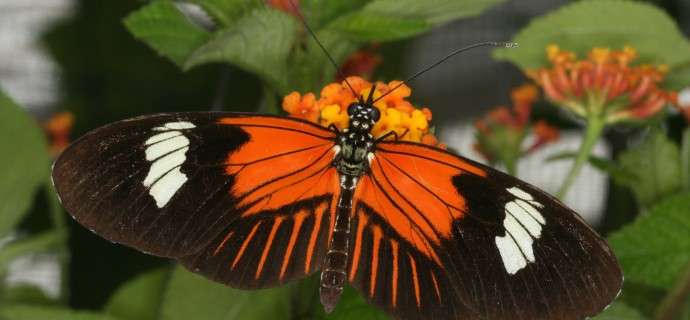
Butterflies' special place in human culture stems from the fact that they have used their wings not only for flight, but as a canvas for some of the most striking patterns in nature. Evolving from an ancestral moth-like insect about 60 million years ago, the sheer beauty of their wings, and the metaphorical power of their emergence fully formed from rather unpromising pupae, has made butterflies an object of admiration and inspiration.
But the nature, development and evolution of these staggeringly diverse decorations (of the more than 18,000 species of butterfly, almost all differ in their wing patterns) has also attracted the attention of scientists; although studied since antiquity, many butterfly secrets continue to be revealed, as this selection of research published in PLOS journals and other open access sources in the last 12 months shows.
Butterfly wing patterning seems to serve many functions related to survival – camouflage, mimicry, mate recognition or warning signals. And because the benefits conferred by these depend in turn on the environment, location and other (equally evolvable) creatures such as predators or other butterflies, the forces underlying pattern evolution are complex, and the mechanisms by which they arise are fascinatingly elegant. A paper just published in PLOS Biology, for example, examines how the wing patterns of 17 species of Amazonian Heliconius butterflies have arisen. The answer, it seems, is that modular chunks of regulatory DNA that control the red colour "master gene" optix have been mixed and matched by mating between different species of butterfly, allowing complex combinations of red "dennis" patches (on forewings) and rays (on hindwings) to emerge in different species. This modularity should make the spread of common mimetic patterns easier, and facilitate innovation.
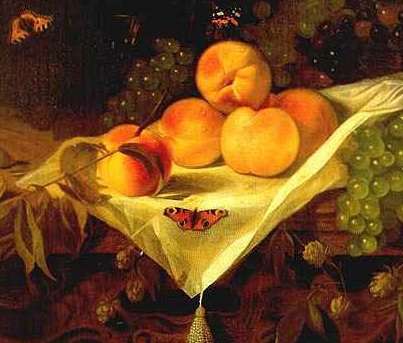
Extreme subtlety of pattern variation is seen in species like Bicyclus anynana, which has different forms in the dry season and wet season to suit the different predators encountered (mostly vertebrates and invertebrates, respectively). The forewing bears eyespots in both forms, as the butterfly can choose when to flash these, but the hindwing is always on show, so while the wet-season form keeps these to ward off invertebrate predators, the dry-season form develops without hindwing eyespots, enhancing its camouflage. How do they do this? A recent PLOS Genetics paper shows that the temperature at which the larvae develop determines the levels of a hormone called 20-hydroxyecdysone, and it's the levels of this substance that determine whether the hingwings develop eyespots (take a look at the authors' own blog post for more detail).
The colours of the scales on butterflies wings arise through two fundamentally distinct mechanisms – through the production of pigment (such as the ommochromes that impart the red colour to the Heliconious patches and rays above) and through nano-engineering of the structure of the scale to create photonic devices. It's the latter "structural colour" that confers the more striking iridescent visual effects seen in butterflies' wings. A recent paper in Scientific Reports set out to emulate the vivid blue colour of Morpho didius by making nanometre-scale Christmas tree-like arrays of polymer that resemble the real Morpho's scales. You can see the convincing results of the nano-mimicry in this picture.
Researchers are also exploring how wings develop during pupation. 3D confocal microscopy in this PLOS ONE study shows that the flat cells that make up the larval wing precursor (the "imaginal disc") expand lengthwise during pupation to give an epithelial layer more than 100 microns deep. Further work by the same group, also in PLOS ONE, shows that the thickness of this epithelium seems to reflect the future wing patterning, such that eyespots correspond to noticeable bulges in the developing organ. The way in which the positions of multiple eyespots might be specified has been modeled mathematically in a further PLOS ONE paper, and a potential role for long-range waves of calcium ions is explored in this BMC Developmental Biology study.
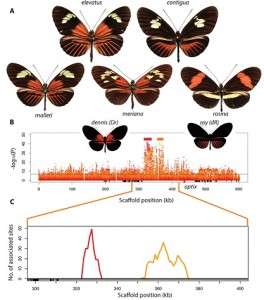
Although wing patterns often serve to reduce the chances of being eaten, predators' eyes aren't the only target audience for the butterflies' wings. A paper in Zoological Letters examines different pigmentary and structural colours in the wings of Papilio xunthus match the spectral properties of their own eyes, consistent with the colours being used to help them spot mates of the same species. Human eyes may also impact butterflies' survival; while species that appeal most to our aesthetic sense might previously have been depleted by the once-popular hobby of butterfly collecting, a PLOS ONE study showed that one aspect of their wing pattern – eyespots – increases the perceived attractiveness of a butterfly and has a positive influence influence on people's attitudes to their conservation.
While this blog post has focused on the beauty of butterflies, we shouldn't forget that their distant cousins are also worth looking at. This PLOS ONE paper uses wing patterns of the basal moth genus Micropterix to show that the relationship between patterning and wing veins has remained almost unchanged in the tens of millions of years since they split from butterflies.
-
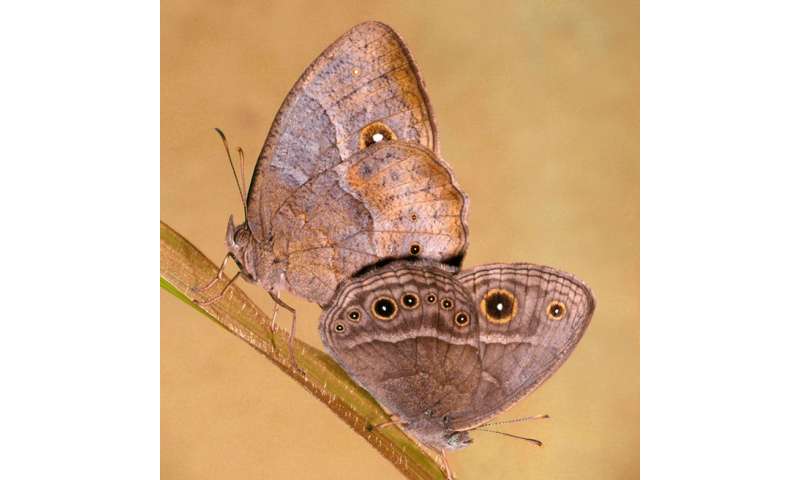
Dry-season form (top) and wet-season form (bottom) of Bicyclus anynana – compare the windwings. Credit: Monteiro et al. -
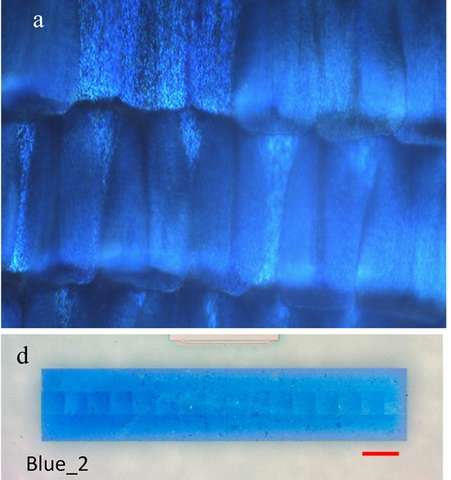
The amazing blue of the real Morpho didius wing (above) and its nanofabricated doppleganger (below) doi: 10.1038/srep16637 -
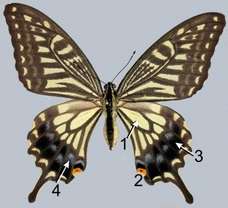
Papilio xuthus‘ eyes are tuned to detect its wing colours (DOI: 10.1186/s40851-015-0015-2) -
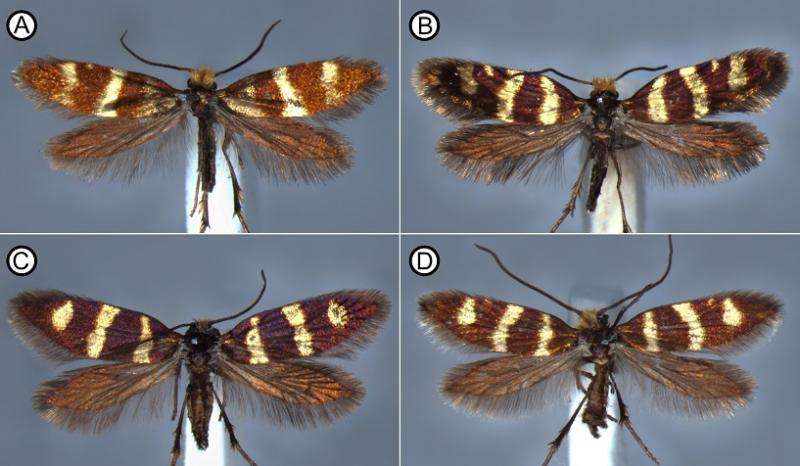
Four species of primitive moth from the genus Micropterix (doi: 10.1371/journal.pone.0139972.g003)
More information: Zoi Manesi et al. Butterfly Eyespots: Their Potential Influence on Aesthetic Preferences and Conservation Attitudes, PLOS ONE (2015). DOI: 10.1371/journal.pone.0141433
Doekele G Stavenga et al. Combined pigmentary and structural effects tune wing scale coloration to color vision in the swallowtail butterfly Papilio xuthus, Zoological Letters (2015). DOI: 10.1186/s40851-015-0015-2
Yoshikazu Ohno et al. Spontaneous long-range calcium waves in developing butterfly wings, BMC Developmental Biology (2015). DOI: 10.1186/s12861-015-0067-8
Yoshikazu Ohno et al. Live Cell Imaging of Butterfly Pupal and Larval Wings In Vivo, PLOS ONE (2015). DOI: 10.1371/journal.pone.0128332
Journal information: PLoS Biology , PLoS ONE , Scientific Reports
Provided by Public Library of Science
This story is republished courtesy of PLOS Blogs: blogs.plos.org.




















